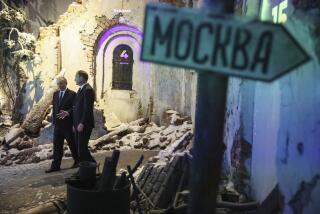NUCLEAR ENERGY : Soviet Republics Still Linked by Atomic Power
- Share via
MOSCOW — The Soviet Union’s richest uranium deposits are in the Central Asian republic of Kazakhstan. But the technology to reprocess nuclear fuel is currently available only in the Russian Federation. The giant Atommash enterprise that produces components for atomic power plants has its facilities scattered across the breadth of the continent. But the brains and the blueprints for their assembly are concentrated in Moscow.
In fact, so dispersed is the Soviet nuclear power industry that no single republic is capable of providing the full range of services--from uranium mining to waste management--needed to operate its plants. And even as the republics pursue independence, their leaders appear to have agreed on at least this much: It would be foolish to tear apart their interdependent nuclear power industry.
Of the 15 republics that made up the Soviet Union before secessions and political chaos divided it, only five had any nuclear power-producing facilities. One, Armenia, shut down its two units because of safety concerns after the December, 1988, earthquake. Another, Kazakhstan, has only one small unit, built to power a water-desalination plant.
Among the three main producers--Russia, the Ukraine and Lithuania--are some of the strongest nationalist movements. But none to date has suggested that nuclear power should go the way of political autonomy.
The Ukraine, which has roughly the same territory and population as France, hosts nearly one-third of the Soviet Union’s 48 nuclear units. It could, over several years, develop its own sources for the services and materials now supplied by other republics. But even those political voices crying loudest for independence have left the civilian nuclear industry off their list of demands for full national sovereignty.
Aside from the prohibitive costs, safety would be thrown into question if any republic attempted to disengage from the tightly bound network, said Leonid Vodolazhko, executive director of the Chernobyl Union in Kiev, a group of experts who banded together after the 1986 Chernobyl accident to work on improving nuclear safety.
All five nuclear-capable republics have agreed to retain central control during an unspecified transition period, according to Viktor Sidorenko, the Soviet Union’s first deputy minister for atomic energy production.
Negotiations are currently under way among the nuclear republics to work out a new division of responsibility and to determine how the output of the plants should be distributed. But no major change is expected for at least 10 years.
One change that may occur sooner than any division or privatization of the nuclear power industry might be the replacement of “exported” managers with local experts, as soon as they can be trained. But for the time being, even the staffing will remain under Moscow’s control, Sidorenko said.
Some Soviet political leaders who advocated retaining a united federation used the nuclear issue as an example of a risk that could be posed by the country’s breakup.
As Parliament member Roy Medvedev argued, the Soviet system is so heavily centralized that some republics even lack the technical know-how to shut their nuclear plants down.
More to Read
Sign up for Essential California
The most important California stories and recommendations in your inbox every morning.
You may occasionally receive promotional content from the Los Angeles Times.











